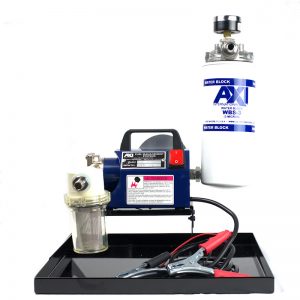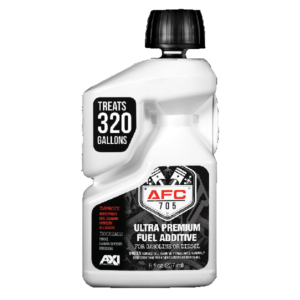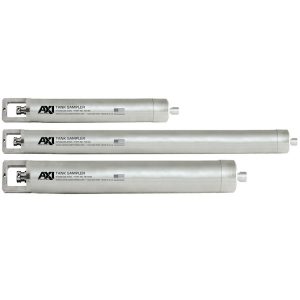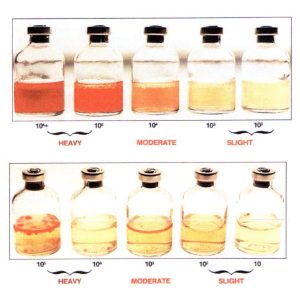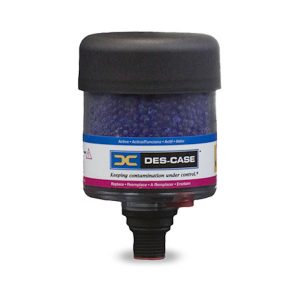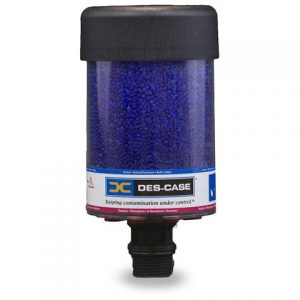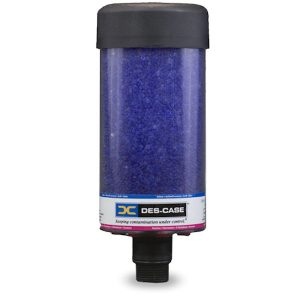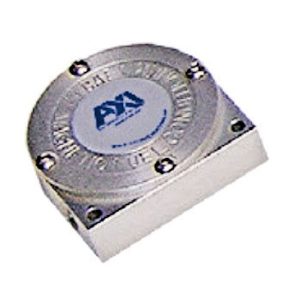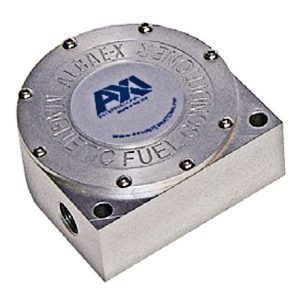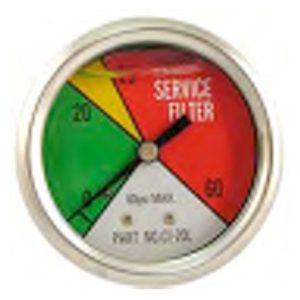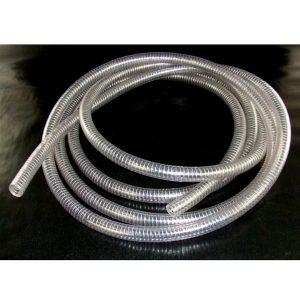Diesel Fuel Polishing
Diesel Fuel Polishing and Fuel Tank Cleaning
for the Do-It-Yourselfer
What Makes Diesel Fuel Go Bad?
If left unmanaged, diesel fuel quality can degrade rather quickly (in less than one year after leaving the refinery, according to Caterpillar), rendering the fuel harmful to an engine. When water is introduced into fuel, a host of potentially catastrophic problems arise and propagate.
 In fact, water is the most damaging contaminant to diesel fuel, and the primary catalyst to additional fuel breakdown. Other contributors to fuel degradation, like microbial growth, sludge, asphaltenes, wax, and particulate, all have their own unique effect on diesel fuel and the diesel engine.
In fact, water is the most damaging contaminant to diesel fuel, and the primary catalyst to additional fuel breakdown. Other contributors to fuel degradation, like microbial growth, sludge, asphaltenes, wax, and particulate, all have their own unique effect on diesel fuel and the diesel engine.
Now any equipment owner, equipment repair shop, farmer, rental equipment business, or motor home owner can do their own fuel polishing, maintaining their fuel quality and removing water and contaminants from fuel tanks without incurring the expense and delay of having a commercial fuel maintenance company come to you to clean your fuel tank. The TK-240 XT Portable Fuel Polishing and Tank Cleaning System is a Do-It-Yourself Fuel Polishing System designed for ease of use.
Symptoms of Bad Diesel Fuel
Clogged and Slimy Filters
Dark, Hazy Fuel
Floating Debris in Tanks
Sludge Build-up in Tanks
Loss of Power and RPM
Excessive Exhaust Smoke
Corroded, Pitted Fuel Injectors
Foul Odor Emitting from Fuel Tank















TK-240-XT-9-20
TK-240-XT-102-lrg-6-18
TK-240-XT-114-lrg-6-18
TK-240-XT-115-lrg-6-18
TK-240-XT-103-lrg-6-18
TK-240-XT-104-lrg-6-18
TK-240-XT-105-lrg-6-18
TK-240-XT-106-lrg-6-18
TK-240-XT-107-lrg-6-18
TK-240-XT-108-lrg-6-18
TK-240-XT-109-lrg-6-18
TK-240-XT-110-lrg-6-18
TK-240-XT-111-lrg-6-18
TK-240-XT-113-lrg-6-18
TK-240-XT-112-lrg-6-18
Fuel Polishing Reverses the Consequences of Bad Diesel Fuel
What is Fuel Polishing?
The term Fuel Polishing comes from the process of taking old, degraded fuel that has become brown or sometimes black in appearance and making it clear and bright and restoring its quality.
Crude oil contains hundreds of different types of hydrocarbons all mixed together. The refining process separates these hydrocarbons for use in various products and purposes. Some of the heaviest components are the asphalts found in crude oil. This is the same product that is used to pave highways. In the refining process, some of these asphalts, commonly referred to as asphaltenes, ends up in diesel fuel products. These asphaltenes don’t usually hurt anything and are small enough, in the 2 micron range, to easily pass through most fuel filters and get burned in the combustion chamber of your engine without problem. Because they are in solution shortly after the refining process, their presence in the diesel fuel is not obvious. But when fuel is in storage for a period approaching a year from when it leaves the refinery (six months for bio-fuels), these asphaltenes agglomerate (combine with each other to form a larger mass). As these clumps grow in size (they can form clumps of 200 microns and larger), they make the fuel appear dark and these clumps often will clog your fuel filter.
Fuel Polishing is the process of passing the fuel through a Fuel Conditioner (see the FAQ Section below for how a Fuel Conditioner works) that will break apart the agglomerated asphaltenes, reducing the clumps to a size where they are returned into solution and the fuel again becomes clear and bright, hence the term “Fuel Polishing”.
What is NOT Fuel Polishing?
Many enterprising individuals and companies market fuel polishing services that utilize a fuel pump, one or more fuel filters (or sometimes some novel filtering media such as paper towels or some other “proprietary” means of removing solids from the fuel), and top it off with a heavy dose of chemical biocides. They make a case for combining the use of strong chemicals with the filtration process, but the fuel does not return to the clear and bright appearance as expected. Also, the fuel does not regain the optimal fuel quality that is expected, and the fuel does not deliver smoke-free combustion nor extend the time between filter changes as promised.
Without a Fuel Conditioner (see “How Does Fuel Polishing Improve Diesel Fuel?” below) that will return the fuel to that clear and bright condition, all you are doing is filtering the fuel. The Fuel Conditioner also is the principal component that rids your fuel of microbial and fungal contamination without the need for biocides or other hard-to-handle chemicals.
Biocides introduce a whole new problem to the situation. The chemicals are quickly diluted and do not achieve total destruction of the microbial and fungal infestation. This growth is contained in the heaving tank bottom sludge and debris. The chemicals cannot penetrate this material and residual microbial growth lingers and quickly begins the reproduction process and, within a few months, the problem of clogged filters is back.
In addition, having this chemical now in the tank bottom water results in this water requiring special handling, just like the biocide containers, in accordance with governmental regulations and mandates.
What Are The First Signs of Bad Diesel Fuel?
Frequent Filter changes and incurring the expense and inconvenience of cleaning fuel tanks have become acceptable periodic maintenance instead of a warning signal for engine failure. Filter elements should last a thousand hours or more, and injectors some 15,000 hours. However, since diesel fuel is inherently unstable, solids begin to form and the accumulating tank sludge will eventually clog your filters, ruin your injectors and cause engines to smoke.
Fuels and oils are susceptible to natural deterioration, like any other organic fluid. Oxidation, chemical incompatibility, water, and microbial infestation all contribute to the process of polymerization and stratification of diesel fuel and other hydrocarbons. This results in poor Fuel Quality, and the formation of sludge, bio film and acids in the fuel tank.
These by-products of the fuel breakdown process cause clogged filters, corroded injectors, pumps and tanks, incomplete fuel combustion (as evident from black smoke, caused by un-burned fuel, coming from the exhaust), carbon build-up on internal engine components, and the loss of power. As these problems build on each other, these individual symptoms of bad fuel ultimately lead to complete engine failure.
Can Bad Diesel Fuel Impact my Engine Warranty?
All major diesel engine manufacturers have set minimum fuel standards for the diesel fuel to be used in their engines, and failing to maintain the fuel that you use in a manner so that it meets those standards could lead to engine component failures and denied warranty claims.
As an example, Caterpillar has published “Cat Commercial Diesel Engine Fluids Recommendations” (SEBU6251-17 September 2014 [a more recent version may be available]) that states “In order to meet expected fuel system component life, 4 micron(c) absolute or less secondary fuel filtration is required for all Cat diesel engines that are equipped with common-rail fuel systems.” (Page 34) You should not assume that fuel being delivered to you meets the manufacturers requirements, and certainly fuel that has been in your storage tank for an extended period of time may not meet requirements of diesel engine manufacturers. Additional cleanliness standards apply to diesel fuel. Caterpillar recommends that the fuel dispensed into the machine tank meets “ISO 18/16/13 cleanliness level.” (Page 49) You can learn more about Fuel Cleanliness Standards at this link.
(Google this document for a complete copy)
How Does Heated Fuel and Pressure Accelerates Fuel Breakdown?
Diesel engines continuously return fuel not used for combustion back to the tank. The repeated exposure to the heat and pressure of the injection system accelerates this breakdown of fuel quality. Fuel quality and fuel chemistry is affected by transportation, storage tank conditions (as well as length of time in storage), and factors such as oxidation, water in the fuel, microbial contamination (contributing to acid formation), and incompatibility of fuel additive packages with after-market additives, etc.
This toxic combination negatively impacts: (i) the filterability of the fuel through filters that become clogged; and (ii) causes a dramatic increase in the size of the fuel droplets emitted from the fuel injector into the combustion chamber. The degraded condition of the fuel, when combined with the injector degradation that occurs over time from the use of the degraded fuel, result in fuel not being completely burned in the combustion chamber causing the formation of carbon deposits on internal engine components, all evidenced by a noticeable increase in smoke from the exhaust, loss of power, and an increase in fuel consumption.
How have Modern Engine Designs Magnified these Problems?
Modern High Pressure Common Rail (HPCR) Fuel Injection, common on engines placed in service since 2007, has been the cornerstone for advances in combustion efficiency and enables a diesel engine to achieve the stringent emissions levels now mandated.
The design of this system is such that a constant fuel pressure is available at the injector 100% of the time during engine operation thus providing a higher available mean time injection pressure over the older Electronic Unit Injector (EUI) designs.
This feature ensures that fuel droplets are atomized the moment they leave the injector nozzle. As EUI systems had to develop the fuel pressure during the injection event, they have a tendency to form larger droplets at the start and end of each injection event. HPCR injection systems are also able to regulate fuel injection pressure based on engine requirements, speed, and duty using the engine ECU combined with the fuel pump.
The high pressure created in these injector systems (which can exceed 30,000 psi) and the smaller tolerances in the injectors require more attention to fuel cleanliness and fuel quality, and have resulted in engine manufacturers requiring a 4-micron final fuel filter to protect this fuel system.
But these clumps of non-fuel create significant problems, including:
excess exhaust smoke
loss of power
higher maintenance costs
shorter injector life
Poor quality or contaminated diesel fuel now contributes to more than 80% of fuel system related failures in modern diesel engines.
How Does Fuel Polishing Improve Diesel Fuel?
Diesel engines continuously return fuel not used for combustion back to the tank. The repeated exposure of the fuel to the heat and pressure of the injection system accelerates the breakdown of the diesel fuel and compromises the fuel quality. Fuel quality and fuel chemistry is affected by transportation, storage tank conditions (as well as length of time in storage), and factors such as oxidation, water in the fuel, microbial contamination (contributing to acid formation), and incompatibility of fuel additive packages with after-market additives, etc.
This toxic combination negatively impacts: (i) the filterability of the fuel through filters that become clogged; and (ii) contamination and corrosion of the injectors, causing a dramatic increase in the size of the fuel droplets emitted from the fuel injector into the combustion chamber. The degraded condition of the fuel, when combined with the injector degradation that occurs over time from the use of the degraded fuel, result in fuel not being completely burned in the combustion chamber causing the formation of carbon deposits on internal engine components, all evidenced by a noticeable increase in smoke from the exhaust, loss of power, and an increase in fuel consumption.
By periodically using the TK-240 XT Fuel Polishing and Tank Cleaning System to maintain clean, clear and bright fuel uncompromised by water and microbial contamination, engine performance is maintained, more economical operation is assured, and engines will last longer.
How Do Fuel Conditioners Fight Microbial Contamination and Polish Fuel?
The LG-X Series Fuel Conditioner is the most important component of the TK-240 XT Fuel Polishing and Tank Cleaning System. Without the Fuel Conditioner, all you would be doing is filtering fuel, and that is not Fuel Polishing!
Operating on the principle of induction on the process of combining kinetic and magnetic energy to influence the behavior of electrons, the LG-X Series Fuel Conditioner provides a powerful magnetic field and the flow of fuel provides the kinetic energy (think about how a generator produces electric power by spinning in a magnetic field). 
The asphaltene component of fuel that has come out of solution and makes the fuel appear dark is still there after the fuel polishing process is performed, but like the fuel when it left the refiner, the Fuel Conditioner causes the asphaltene component to go back to being in solution and you again have clear and bright fuel. Microbial contamination, having passed through this magnetic field repeatedly, has been impacted and its reproduction process is compromised. You cannot say these “bugs” are dead (they are still present), but they remain inert for months while the fuel is used and periodic re-circulation of the diesel fuel assures that their presence does not grow. This infestation will in time pass through the combustion chamber and be gone.
Are There Other Benefits to the Fuel Conditioner?
As the Fuel Conditioner does not filter the fuel, but treats it as it passes through the unit, there is seldom any reason to suspect that a restriction exists in the LG-X Series Fuel Conditioner. However, there are situations where the benefit of circulating your fuel through a magnetic unit has added benefit.
Should the LG-X Series Fuel Conditioner be used in a situation where it is installed in-line on the fuel line between the fuel tank and the engine, the Fuel Conditioner can provide continuous Fuel Polishing, but also provide added protection to your engine.
If a fuel tank itself is in poor condition, where the tank may be rusted on the inside and rust flakes may be coming loose, or an upstream storage tank was old and rusted, the LG-X Series Fuel Conditioner would prevent the sharp metal flakes from progressing to the fuel filter where they may pierce the filter medium and allow unfiltered fuel to proceed to the fuel system to create havoc on your injectors. Also, should the source of your fuel be questionable, such as a marine vessel that fuels at island fuel stops with little oversight, or remote mining operations where a supplier may not be reliable, having the LG-X Series Fuel Conditioner installed on each item of equipment to stop metal shavings or other ferrous debris that may be the result of lax maintenance on upstream distribution equipment could be a great benefit.
 If a fuel blockage in the fuel system occurs, and the Fuel Conditioner is suspected to be the cause, simply remove the cover plate, carefully remove the magnet and wipe it clean with a shop rag. Carefully replace the magnet and re-attach the face plate. A parts kit with replacement O-ring and attachment screws is available (call for more information).
If a fuel blockage in the fuel system occurs, and the Fuel Conditioner is suspected to be the cause, simply remove the cover plate, carefully remove the magnet and wipe it clean with a shop rag. Carefully replace the magnet and re-attach the face plate. A parts kit with replacement O-ring and attachment screws is available (call for more information).
The process of how the LG-X Series Fuel Conditioner makes clear, bright and more combustible fuel, as well as restoring degraded fuel and eliminating the effects of microbial contamination, is compelling.
How Does the Fuel Polishing & Tank Cleaning System Also Clean the Fuel Tank?
It is critically important to re-circulate the fuel through the TK 240 XT Fuel Polishing and Tank Cleaning System. But the re-circulation process alone does not create sufficient fuel flow and agitation in the tank during the tank cleaning process. In most instances, there is not enough force created with the fuel flow being discharged back into the tank to really knock the slime and sludge off the sides and inside-top of the tank and stir up the years of accumulated sludge on the tank floor!
What you need is something to clean the tank and put this bio-film and slime into the fuel flow so that the TK-240 XT Fuel Polishing and Tank Cleaning System can filter out the debris, the Fuel Conditioner can get to the microbes, and the agglomerated asphaltene component of the fuel can be broken down and removed from the fuel stream.
Although moving the suction hose stinger (an extension to the hose, usually rigid, allowing for the control of the suction line intake end) of the Fuel Polishing System around the bottom during the fuel re-circulation phase does stir up considerable material for the suction line to deliver to the TK-240 XT Fuel Polishing System, there needs to be something that can dissolve the slime and organic material off the tank walls, top, and floor prior to and during the re-circulation process that will also keep working between Fuel Polishing Treatments.
It is recommended that the diesel fuel tank be treated with the AFC Series Broad Spectrum Additive Concentrate appropriate to your application a day or two prior to the first re-circulation.
The AFC Series of Fuel Catalyst and Tank Cleaning Additives are available in three varieties. The AFC-705 is for pre-2007 manufactured engines and includes in its chemical makeup a surfactant that helps in the removal of residual water from the fuel tank bottom.
The AFC-710 is available in both liquid and powdered form and is Tier-4 compliant meant for 2007 and newer engines. This product lacks the surfactant and dispersant components to comply with Tier-4 requirements. Otherwise, this product is an excellent fuel catalyst and tank cleaning additive.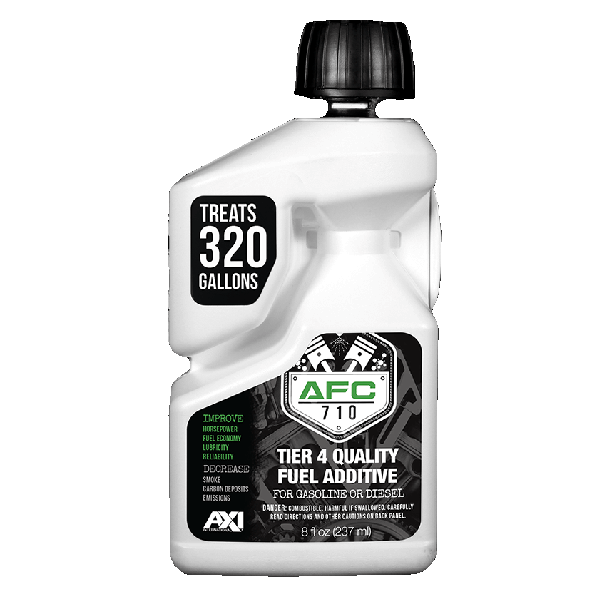
AFC-805 is a cold weather fuel catalyst and tank cleaning additive for use in cold weather environments and is Tier-4 compliant meant for 2007 and newer engines. It likewise effectively decontaminates and cleans an engine’s entire fuel and injection system and continues to work in cleaning storage tanks and stabilizing fuel for up to twelve months.
The AFC-Series additive that suits your needs should be added to a full tank of fuel (after any accumulated water is removed) or the tank filled just after the additive is introduced to the tank.
After completing the initial fuel polishing re-circulation, continue the use of AFC Series Additives at least once or twice every six months thereafter to continue the tank cleaning process continues for badly contaminated tanks. This will enhance and accelerate the long term tank cleaning process, mainly the hardened sludge in the tank bottom, by breaking down and dissolving the existing tank sludge.
For tanks that are not so badly contaminated, use of the AFC Series Additives periodically will assure the fuel tank remains clean and the fuel is stabilized.
What Should I Do in the Future to Keep My Fuel Tank Clean and My Fuel in Good Condition?
Perform a Fuel Re-circulation every six months with the TK-240 XT Fuel Polishing System and Check the Tank Bottom for Water at Regular Intervals
Always check the fuel tank for an accumulation of water in the bottom of the tank prior to doing a re-circulation. Using a rod, sometimes used to measure fuel in a storage tank, or a length of 1/2 inch PVC pipe, spread a line of Kolor Kut Water Finding Paste on the side of the rod or pipe and insert to the bottom of the tank, allowing it to remain for several minutes. If the paste touches water, it will change colors, showing how much water is in the tank requiring removal prior to initiating the re-circulation process.
Add the AFC Series Fuel Additive to your fuel tank appropriate for your equipment. Treating a full tank of fuel is important as you don’t want to clean just the bottom half of the tank. You want the additive treated fuel to touch every part of the sides and, if possible, the top of the tank — anywhere the fuel touches during equipment operation.
The AFC Series Fuel Additives are industrial strength and concentrated for the focused dual-purpose of:
First – working hand-in-hand with the TK-240 XT Fuel Polishing and Tank Cleaning System by cleaning the fuel tank in preparation for the periodic re-circulation and treatment of the fuel; and
Second – as a continuing part of a Fuel Management Plan to maintain the cleanliness of storage tanks and fuel systems, and assuring that your fuel maintains Optimal Fuel Quality. This is defined as fuel that is like it was when it left the refinery. The TK-240 XT Fuel Polishing System, working with the AFC Series Tank Cleaning Additives, assure your fuel is of optimal quality for as long as you depend on the fuel to efficiently operate your equipment.
Removal of Residual Water
Prior to the initial and any subsequent fuel polishing re-circulation, pump any measurable accumulated water out of the tank for proper disposal. It is, however, often impossible to remove all of the water. The AFC-705 Catalyst and Tank Cleaning Additive contains a surfactant that will emulsify this residual water up into the fuel for removal by a Water Block Filter on the TK-240 XT Fuel Polishing System.
The AFC-710 Catalyst and Tank Cleaning Additive, available in both liquid and powder form, and the AFC-805 Cold Weather additive, both of which is Tier 4 Compliant, does not include the surfactant component, but otherwise works the same as the AFC-705 to dissolve deposits and stabilize the fuel. As an option to the liquid AFC-710, a powdered form of AFC-710 is also available. It is easier in certain instances to handle, store and transport.
Additive Dosage
Depending on the condition of the fuel and the amount of sludge build-up, it is recommended to initially use a double dose of one to twenty-five hundred (1:2500 – one oz. to 20 gallons of fuel) and circulate the capacity of the tank five times. The use of AFC Fuel Catalyst & Tank Cleaning Additive has proven to be essential in accelerating the tank cleaning process. The AFC Series addivites contains corrosion inhibitors, lubricity enhancers and combustion catalyst.
For engines manufactured in 2007 and later, use AFC-710, available in both liquid and powdered form. AFC-710 and AFC-805 does not contain the dispersant and surfactant (used to emulsify residual water into the fuel for removal in the circulation process as does AFC-705), a component that does not allow for qualification as a Tier 4 product.
Tank Cleaning & Fuel Treatment for Cold Weather Use
For cold weather operations, AFC Fuel Catalyst AFC-805 is a unique and powerful anti-gelling broad-spectrum fuel additive specifically formulated for use in Diesel, Bio-fuels, Gasoline, Kerosene, and HFO. AFC-805, also Tier 4 compliant, can be used as part of any preventative fuel maintenance program, and is ideal for use in bulk storage fuel tanks in cold weather environments. AFC-805 enhances the breakdown and removal of sludge, slime, and bio-fouling from tank walls and baffles that are difficult to access. It continues to work in storage tanks cleaning and stabilizing fuel for up to 12 months with a single dose.
Marine Vessels of All Types Commonly Experience Water Accumulation in their Fuel Tanks and Microbial Growth that Cloggs Filters and Compromises Performance

Stored Fuel
Management
A Critical Component for Every Equipment Owner
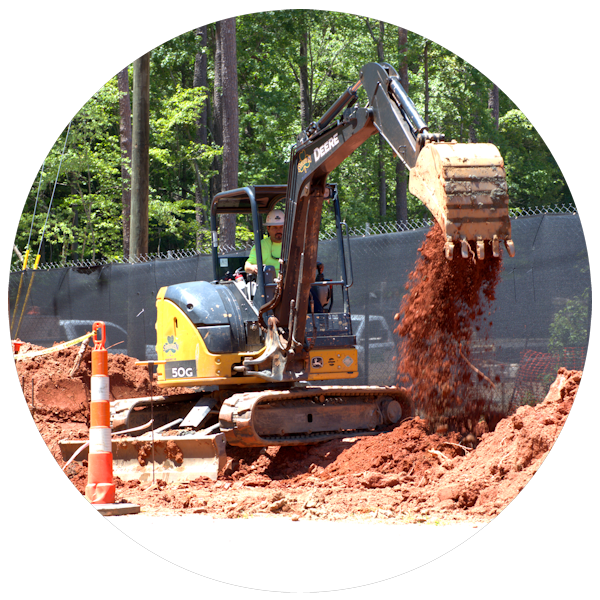
Fuel Polishing Products for the
Do It Yourself Equipment Manager
View cart “DC-3 Desiccant Vent Breather – 3-Micron – Disposable (AA0782)” has been added to your cart.
-
- Fluid Sampling
Fuel Sample Bottles
- $12.65 – $56.90
- Select options
Diesel Equipment Used Seasonally, Equipment That is Idle for Long Periods, Such As Rental Equipment, and Businesses Located in High Humidity Regions Will Benefit From an Active Fuel Management Program
Tips & Tricks in Do It Yourself Fuel Management
Checking for Water in Your Fuel Tank
Using Kolor Kut Water Finding Paste to Check for Water in your Tank is easy.
Water Finding Paste will change color when it touches water. Place a “smear” of Water Finding Paste on a wood rod or length of PVC pipe extending from the end of the pipe for several inches up the pipe. Stick the end of the pipe down into a tank fuel, kerosene or heating oil so the paste is on the end at the bottom of the tank. Allow it to stay in this position for from several to ten minutes, and then remove and inspect the rod. Try to direct the rod or pipe to the low end of the tank as water will collect at the low point of the tank.
If there is water in the tank, the paste will change color. If two inches of the paste changes color, you have two inches of water in the tank.
Check To See What Water, Sludge, & Debris is in the Bottom of Your Fuel Tank
Cut a length of 1/2″ PVC pipe so you can place it into your fuel tank to the tank bottom while still holding onto the other end. Use it like a soda straw, placing your thumb over the end before putting it into the fuel tank. Insert the tube into the tank until the end hits bottom.
Then remove your thumb so whatever is at the tank bottom will flow up into the PVC pipe. Replace your thumb on the end and then remove the pipe. Place the end of the tube that was at the tank bottom into a clear 2-litre bottle, such as a soda bottle, and remove your thumb so the fluid empties into the bottle. (Place the 2-litre bottle into a 5-gallon bucket to catch an spillage.) Repeat this process several times, filling the soda bottle at least half way.
Note that if your fuel storage tank is filled from the top, the flow of new fuel entering the tank, when directed straight down to the tank bottom, may displace sludge and debris from the area immediately below the fuel fill access. Insert the PVC pipe on an angle so it can extend to the extremes of the tank to avoid a false finding of no sludge or debris in the tank bottom. If one end of the tank is lower than the other, concentrate your efforts on this low end of the tank.
Take care to extend the PVC pipe to all areas of the tank bottom when using this method to remove water and tank bottom debris.
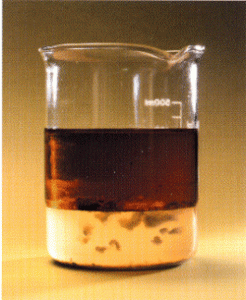 Allow the fluid in the bottle to settle (possibly overnight) and inspect it. Water, if any, will separate and be visible in the bottom of the bottle. You may also see any sludge and debris that may have accumulated in your tank and the organic material that is the byproduct of a microbial contamination (sometimes erroneously referred to as “algae”) in the soda bottle.
Allow the fluid in the bottle to settle (possibly overnight) and inspect it. Water, if any, will separate and be visible in the bottom of the bottle. You may also see any sludge and debris that may have accumulated in your tank and the organic material that is the byproduct of a microbial contamination (sometimes erroneously referred to as “algae”) in the soda bottle.
This water, sludge and debris can then be removed with the TK-240 XT Fuel Polishing and Tank Cleaning System by connecting the PVC pipe to the end of the suction hose. Remove all water and debris and pump it into a container for disposal, and then re-circulate the fuel (see the step by step process of Polishing Fuel in the Frequently Asked Question section below).
Removing Free Water from Your Fuel Tank
Cut a length of PVC pipe so you can place it into the tank to the tank bottom while still holding onto the other end. Use it like a soda straw, placing your thumb over the end before putting it into the tank. Insert the pipe into the tank and when the end hits bottom, remove your thumb so that any water that is at the tank bottom will flow up into the PVC pipe. Replace your thumb on the end and then remove the pipe. Place the end into a clear 2-liter bottle and remove your thumb so the fluid empties into the bottle. Repeat several times. Allow the fluid to settle and inspect it. Water, if any, will separate and be visible in the bottom of the bottle.
Repeat the above process until you get only fuel from the tank bottom. You may need to use several 2-liter bottles, or, with larger tanks, a 5-gallon container.
If there is a lot of water to be removed, you can use the TK-240 XT Fuel Polishing System pump to suction the water out of the tank and pump the water into a separate container, such as a 30 or 55 gallon drum. Always dispose of this waste water properly in accordance with your local State and Local regulations. Note that if you have previously used a biocide additive in the fuel, the water may require special handling.
Emulsified water (water that is mixed in with the fuel) makes the fuel appear cloudy or milky. Using the TK-240 XT Fuel Polishing System with the supplied Water Block filter will remove this emulsified water.
How to Prevent Water from Getting Into Your Fuel Tank
The most important part of fuel maintenance is preventative steps to keep water from entering your tank. If water does find its way into the fuel tank, removing it as soon as is practicable is critical.
Desiccant Standard Disposable Breather
When fuel is removed from a tank through regular use, the fuel is replaced with air that is typically drawn in from outside of the tank through a vent pipe. Moisture and microbes (along with pollin and fungi) are commonly pulled into the tank with the air.
Fuel in long term storage can accumulate water in the tank bottom as well. As the ambient temperature changes, the fuel will expand and contract, and this action will cause the air to be pulled into the tank, and then expelled from the tank. Moisture in the air will condense on the walls of the fuel tank and these droplets of water will eventually find their way to the bottom of the tank. Accumulated water in the tank bottom is the habitat in which the microbes that are drawn into the tank with the air will reproduce.
Tanks should be checked at least every sixty (60) days to be assured that water is not accumulating. Without water, the microbes do not reproduce.
A Desiccant Fuel Tank Breather (available in five sizes: DC-BB for up to 15 gallon storage tanks, the DC-1 for up to 35 gallon storage tanks, the DC-2 for up to 200 gallon storage tanks, the DC-3 for up to 350 gallon storage tanks, and the DC-4 for up to 500 gallon storage tanks) installed on the vent pipe presents a good option for preventing water from entering your tank, especially if you are located in a climate with high humidity and wide temperature changes.
The Desiccant Tank Breather provides a simple yet dependable defense against not only moisture in the air from entering the storage, but also particulate contamination (dust, air-born dirt, pollen, fungi, etc.) from entering the storage or equipment fuel tank.
Water may also enter your tank will fuel fills. This is highly dependent on the attention to tank maintenance practiced by your fuel supplier and other storage facilities upstream from your fuel supplier to the refinery.
Tank Access Plates
Some equipment have fuel tanks tucked into confined space and do not provide inspection ports that are easily accessible, nor fill points that allow for access to inspect fuel tank bottoms and determine the presence of water.
Tank Access Plates (both Aluminum and Stainless Steel) are available to provide easy access to a fuel tank, or add a second access for tanks that may contain internal baffles.
WE-12 Water Eliminator
However, tanks that do have easy access should be equipped with a means of capturing and holding water for removal. The Water Eliminator is a highly effective device that is placed in the bottom of the fuel tank and, when fuel is added, may be removed and inspected to determine if any water has entered the tank and captured by the water eliminator device. It is an easy and cost effective means of being assured that your tank is free of water.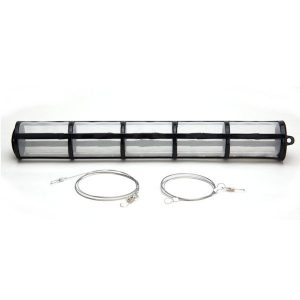
Without a place to reproduce, the microbes will float around and eventually be pulled into the fuel flow, consumed in the combustion process, and will not adversely affect your engines efficient operation.
The Suction & Discharge Hose
The TK-240 XT Fuel Polishing System package includes 15 feet of suction and 15 feet of discharge hose, both ½ inch (inside diameter). Purchase hose barb fittings and clamps at your local plumbing or hardware store to attached pipe extensions or other fittings to the hose. The suction hose is a clear material with metal reinforcing. As fuel is suctioned by the TK 240 XT Fuel Polishing System, the clumps of sludge and organic material is visible coming up through the suction hose.
It is important to monitor the flow of this sludge and debris to know when to change filters and move to a smaller micron rated filter. As contaminated fuel will discolor the clear hose, we recommend that you do not insert the suction hose into the fuel tank. Use of the extension pipe keeps the clear hose much cleaner.
PVC pipe is often used as an extension, especially when a long extension pipe is required. But PVC can easily break when bent, so an alternative is PEX pipe. It has more flexibility for shorter and mid-range reach to extreme ends of a fuel tank.
The discharge hose should be secured at the entrance to the tank using an alligator clam or a ball and elastic strap so that it does not accidentally flop out and discharge fuel on the ground. Often a 90 deg. elbow is affixed to the discharge hose to direct the flow to the ends of the tank promoting a flow that would move debris on the tank bottom to an area of the tank that can be easily reached with the suction hose extension.
Placing Both Suction & Discharge Hoses in the Same Tank
Use a length of PVC or PEX as an rigid extension to the suction hose to reach to the bottom of the fuel tank (sometimes called a “stinger”). Move the extended hose end around the tank bottom like you would move a vacuum cleaner around on a carpet you are vacuuming.
Insert the discharge hose into the tank so that it is discharging near the top of the tank. It can help to agitate the fuel as much as possible during the re-circulation process to direct the discharge flow in different directions. If you put a 90 deg. pipe elbow on the end of the discharge hose to direct the flow to the side, this will help in agitating the fuel in the tank and mix the fuel additive in the fuel for cleaning the tank walls. Periodically change the direction of the discharge to move fuel for each end of the tank.
What to Do When Convenient Access to a Fuel Tank is Not Available
You have experienced one or more of the symptoms of Bad Diesel Fuel, and you now recognize that the diesel fuel in the fuel tank of your marine vessel or equipment is in dire need of cleaning and the fuel, in order to be usable (and avoid the cost and hassle of disposing of a tank of diesel fuel) needs a good “Fuel Polishing“.
Now you need to determine if you are able to get two hoses into the tank (one suction hose and one discharge/return hose) in order to perform the tank cleaning. The size of the hoses being used on your TK-240 XT Fuel Polishing System is about 3/4 inch (outside diameter). Some fuel fill caps may be large enough to accommodate the hoses, but some may be too small, and others may have an anti-siphon device installed at the fuel fill that prevents you from accessing your fuel tank via this route.
An alternative may be to use an access port if it is available in the tank, or an opening that is where the fuel gauge sending unit is located in the fuel tank. But these options may not be available.
There is also the problem common to base tanks (sometimes called belly tanks) that are often used for standby power generators. The generator is mounted on top of the fuel tank, and typically there are several internal structural supports inside the tank to support the weight of the generator. These supports act as baffles inside the tank. Cleaning the bottom of the tank in between these baffles is exceedingly difficult.
Now what do you do?
The Seabuilt Tank Access Plates, comes in 6, 8, and 10 inch cover-plate diameters and is available in either aluminum or stainless steel, provide an easy means to access fuel tanks. If your fuel tank has a number of baffles, as some marine and generator “belly tanks” may have, you may need to install a Tank Access between each baffle.
Installation is easy (see video at the product page). Use the bolt ring as a template, a saber saw to cut the hole and a drill for the bolt holes. Note that minor bits of metal debris is likely to fall into the tank. This material should be suctioned out with the TK-240 XT Fuel Polishing unit prior to restoring the equipment to service.
No gasket sealer is needed. Just tighten the nuts supplied until the outer gasket is compressed and swells slightly from the edge of the outer plate, but do not over-tighten and severely distort the gasket. Make sure all surfaces are clean and dry during installation.
Some of our customers have had the cover plates modified to include a suction tube welded to the cover plate that extends down to the bottom of the tank as a suction line, and a shorter return tube that acts as a return line. Ball valves or Quick Connections are attached to the tubes where space allows so that the hoses from the TK-240 XT Fuel Polishing System can be quickly attached.
Permanent installation of fuel hose to the suction and discharge tube are also common for installations of Fuel Polishing Systems. The portions of the tubes outside the tank may be extended with flexible hose from the Tank Access Plate to a more convenient location for connection to the Fuel Polishing System hoses.
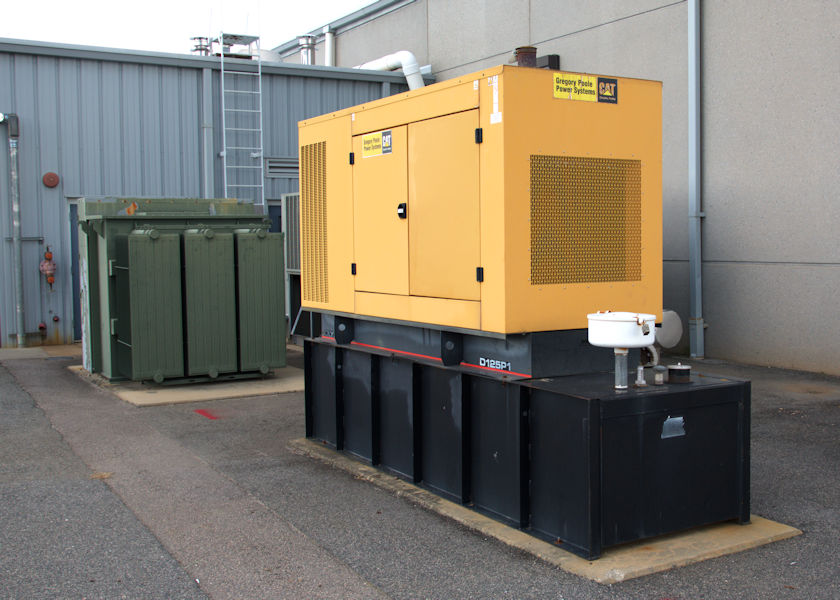
When Power Fails and the Lights Go Out, Backup Power Equipment is Totally Dependent on the Quality of Your Fuel
Frequently Asked Fuel Polishing Questions
What is the Step By Step Process of Polishing Fuel & Cleaning a Fuel Tank?
Preparation — Having the tools and supplies handy that you need to undertake a complete fuel polishing process will make the job go easy:
1.) The TK-240 XT Fuel Polishing System
2.) AFC Series Diesel Catalyst and Tank Cleaning Additive, either the AFC-705 or AFC-710 (Tier 4 Compliant), to assist in the releasing of debris and organic materials from the sides, bottom and top of the fuel tank
3.) Gloves of a material that will prevent diesel fuel from getting on your hands
4.) At least two 2-liter soft drink containers
5.) One five gallon bucket
6.) One length of ½” PVC pipe of a length suitable to reach the bottom of the tank while extending out through the fuel fill opening of the tank (or other opening into the tank) large enough to allow for the insertion of both hoses of the TK-240 XT System into the tank.
7.) One length of ½” PVC pipe of a length to reach the extreme ends of the tank (this can be the same PVC pipe as above) for extending the reach of the suction hose on the TK-240 XT to the extreme ends of the fuel tank. You will also need:
a PVC pipe adapter on the upper end of the PVC Pipe for connection of a fitting with pipe threads;
a ½” barb hose adapter fitting to pipe threads; and
a hose clamp for connecting the suction hose to the barb fitting (this is included in the XT package, but having spares is a good idea).
This is called a “stinger” and will be used to maneuver the suction end of the PVC pipe around the bottom of the tank to suction as much residual water and debris as possible from the tank bottom
8.) Alligator clamps and/or ball bungee cords – some tank openings are large enough that you can use an alligator clamp to secure the suction and discharge hose to the tank opening, helping to prevent the hose from vibrating out of the tank opening while the TK-240 XT is operating. Depending on the tank opening, other means of securing the hoses in place, such as ball bungee cords, may be necessary and are recommended.
9.) Filter Pliers or strap that will facilitate the removal and replacement of fuel filters from the TK-240 XT Fuel Polishing System.
Determine how long to run the TK-240 XT:
1.) The TK-240 XT Fuel Polishing System will recirculate fuel at the rate of 240 gallons per hour. However, if you have a 240 gallon fuel tank that you wish to clean and polish the fuel it contains and you operate the Fuel Polishing System for one hour, you will not have circulated all of the fuel through the system. Without getting into an advanced discussion of Fluid Dynamics, suffice it to say that operating the Fuel Polishing System for one hour will only actually treat about 65% of the fuel in the tank. Operating the Fuel Polishing System for three hours will have treated about 90% of the fuel, and for five hours will treat 98% of the fuel.
There are situations that warrant the use of a separate tank that can hold all of the fuel being polished, like when time is critical. When you use the TK 240 to transfer fuel out of a storage tank pumping it into a separate tank, and then pumping it with the TK 240 transferring the fuel back to the original storage tank, this procedure will treat 100% of the fuel twice and is the quickest and most complete means of polishing the fuel.
Using what is commonly referred to as the closed loop method where fuel is pumped through the TK-240 and then returned directly to the storage tank, we recommend you circulate the fuel five re-circulation cycles the first time you clean a tank that is known to have contaminated/degraded fuel in the tank. After this first fuel polishing, subsequent preventative maintenance fuel polishing can be done using three re-circulation cycles.
An example of determining how long to operate the Fuel Polishing System using the closed loop method, assume you have a 500 gallon storage tank that is known to contain contaminated fuel. Divide 500 by the 240 gallons per hour to determine that one re-circulation will take 2.08 hours (125 minutes). Five re-circulation cycles will take 10.4 hours (2.08 x 5 = 10.4). Each of the three Phases during your initial Fuel Polishing Process would 1/3 of the total time, about 3.5 hours.
A preventative maintenance treatment would circulate the fuel three (3) times, for a total time of 6.25 hours.
2.) Always begin a fuel polishing with a full tank of fuel. Performing a fuel polishing with half a tank of fuel will only achieve the cleaning of the bottom half of the fuel tank. The entire tank should be treated and cleaned.
3.) Obtain a “before” sample of the fuel for later comparison to the fuel’s appearance after completion of the fuel polishing by using a length of PVC like a soda straw, placing your thumb over the end before putting it into the tank. Insert into tank and when the end hits bottom, remove your thumb so whatever is at the tank bottom will flow up into the PVC pipe. Replace your thumb on the end and then remove the pipe. Position the 2-liter bottle in the 5-gallon bucket to catch any spillage. Place the end of the PVC pipe into the clear 2-liter bottle and remove your thumb so the fluid empties into the bottle. Repeat several times until the bottle is at least 2/3 full. Set the bottle aside for use in comparing to the “after” sample to be taken after performing the fuel polishing process.
4.) For the initial treatment (of a known contaminated tank), add the AFC-705 or AFC-710 (Tier 4 Compliant) additive at a liquid dosage of 1 oz. to 20 gallons of fuel. For subsequent preventative maintenance, the dosage is 1 oz. to 40 gallons of fuel (See the AFC-710 Powder Product Pages in the Shopping Cart section of this web site for additional dosage information). You may put the additive in the day prior to a planned fuel polishing treatment to allow it to work on breaking down the debris and contamination, but is not required to be effective. Note that an 8-oz bottle of AFC-710 is included with the TK-240 XT package. Consider purchasing additional additive if you are performing a fuel polishing on a tank larger than 160 gallons (8-oz bottle at 1 oz to 20 gallons (8 x 20 = 160 gallons of fuel)).
5.) Separate the total time run into three phases of fuel polishing, with the following being what is performed in each phase.
Phase 1 — Remove the piping of the TK-240 XT that attaches to the spin on filter head and place the hose barb on the pipe that exists the Fuel Conditioner. In the first phase you will use only the TK-070 screen and the Fuel Conditioner as the fuel is recirculated. The first phase will utilize the stinger (see above) attached to the suction hose to suction up the course debris, sludge and clumps of bio-fuel from all areas of the tank bottom and will be screened out. The screen will clog quickly at first and you will need to stop the system frequently and disassemble the screen to clean it out. Performing the first phase of the re-circulation process in this manner saves the cost of the spin-on filter element. You can perform the first phase with the spin on filter included in the circuit, but you will likely use a filter or two during this phase if your tank is badly contaminated. Do not remove the spin on filter during subsequent preventative maintenance cleanings.
Keep track of the down time when the system is not running and add this time to the end of Phase 1. Watch the sludge and dark clumps of debris come up through the clear suction hose. When you no longer see these clumps and the screen does not require repeated cleaning, you may go on to Phase 2, but add the time not spent on Phase 1 to Phase 2 so your total cleaning time is not reduced. You may find that you quickly remove the solids and sludge from the tank bottom.
Phase 2 — Reconfigure the piping so the spin on filter is installed after the Fuel Conditioner and the hose barb that connects to the discharge hose is on the end of the discharge from the spin-on filter. Do not remove the TK-070 screen. Continue using the stinger on the end of the suction hose positioned so the fuel from the lowest point in the tank is being suctioned. Begin Phase 2 using the FFS-10 Filter which is a 10-Micron Particulate Filter Element. Continue the circulation for the balance of Phase 1 time, if any, and all of the Phase 2 time.
Watch the gauge on the top of the spin on filter head. If the needle gets into the red zone, this means the filter has reached its capacity in particulates, debris, sludge, etc. causing a restriction in the flow and a new filter needs to be installed in its place. It is difficult to estimate how long a filter will last as it is highly dependent on how much debris and sludge remains in the tank.
If you continue clogging filter elements as you near the end of the Phase 2 allocated time, you should extend the time spent on Phase 2 until the filters are lasting longer. Do not shorten the allocated time in Phase 3.
Phase 3 — Continue the Fuel Polishing Process using the WBS-3 3-Micron Water Block Filter element and continue using the stinger as in Phase 2. This filter element contains special filtration material that will not only stop and hold finer particulate down to 3-microns, but also prevent water from passing through the filtering material. Accumulation of particulates and water in the filter will restrict the flow of fuel. When the needle on the pressure gauge on the top of the filter head gets above 20 psi, the filter should be removed and replaced with another WBS-3 Filter Element.
Using the length of PVC pipe and a separate 2-liter bottle, obtain another sample of fuel. Compare this “after” sample to the “before sample” obtained prior to starting Phase 1 to see the improvement in the appearance of the diesel fuel.
Why is it So Important to Keep Water from Accumulating Inside your Fuel Tank?
Water can accumulate in a fuel tank as a result of condensation of moisture that is in air drawn in via the fuel tank vent as fuel is used or when water contaminated fuel is pumped into the storage tank (this is not as common as many think). It often takes a long time, sometimes months, for enough water to accumulate in a fuel tank to become noticeable or cause problems.
Water is the habitat that harbors various organic growth, including microbes, fungi, yeast, etc. that comes into the fuel tank with the air flow. As the microbes reproduce, they create slimy organic debris and sometimes acids in the fuel that clogs filters and corrodes fuel system components.
As the fuel pickup on a typical tank is a couple inches off the bottom of the tank, in most cases the water that accumulates in the tank is not picked up when running the equipment, so it will not be drawn through fuel / water separators or water block filters mounted along the fuel suction line.
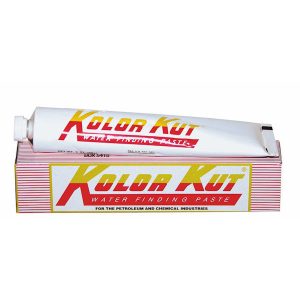 Periodic checking for water in a fuel tank is critical. Use Water Finding Paste every 30 to 60 days, such as the Kolor Kut Water Finding Paste to determine how much water is in your fuel tank. Smear a line of paste from the bottom up several inches on a rod or length of PVC pipe. Place the rod into the tank from the top down to the bottom and hold there for several minutes. Remove and inspect the paste. The paste will change colors if it touches water. Remove any water that may be present.
Periodic checking for water in a fuel tank is critical. Use Water Finding Paste every 30 to 60 days, such as the Kolor Kut Water Finding Paste to determine how much water is in your fuel tank. Smear a line of paste from the bottom up several inches on a rod or length of PVC pipe. Place the rod into the tank from the top down to the bottom and hold there for several minutes. Remove and inspect the paste. The paste will change colors if it touches water. Remove any water that may be present.
You may also use the Water Eliminator that captures water directly from the fuel or oil in the tank. The crystals contained inside the Water Eliminator are water specific and will swell encapsulating the water until the cartridge is full. Water specific means they will only absorb the water in your fuel tank.
 The Water Eliminator presents an easy and economical solution for removing water from tanks used to store fuel. It may be installed in equipment tanks, fuel stored in day tanks to meet surge demand, or larger storage tanks. Maintaining fuel free from water reduces the potential for microbial contamination and accumulation of sludge in tanks.
The Water Eliminator presents an easy and economical solution for removing water from tanks used to store fuel. It may be installed in equipment tanks, fuel stored in day tanks to meet surge demand, or larger storage tanks. Maintaining fuel free from water reduces the potential for microbial contamination and accumulation of sludge in tanks.
How Does Water Get Into the Fuel Tank?
There are several ways for water to get into the fuel tank, and many people tend to blame their fuel supplier for including it in a fill up of the equipment or storage tank.
Sometimes a fuel cap is left off before a rain or other mistakes are made, but by far the most common is the result of just using the fuel!
As the fuel level in any given tank is reduced by usage, it is replaced by air pulled in through a vent. With that air comes moisture, particulates, pollen, fungi and other microbes that are always in the air around us. With temperature change, the moisture condenses on the tank walls and slowly accumulates in the tank bottom. This gives the microbes a habitat in which they thrive and feed off the additives in the fuel. They reproduce quickly and, in a perod of typically six to nine months, the result is a contamination problem that clogs filter, causes acids that corrode fuel system components, including major damage to fuel injectors.
What is the “Shelf Life” of Diesel Fuel?
Even when all fuel storage maintenance practices are followed, Caterpillar recommends a maximum of 1 year from production for distillate ULSD diesel fuel storage, and a maximum of 6 months from production for bio-diesel and blended bio-diesel storage. Storage life for bio-diesel and bio-diesel blends that are greater than B20 may be much shorter than 6 months. (Caterpillar® Commercial Diesel Engine Fluids Recommendations – Fuel Specifications – page 45 – SEBU6251-17 September 2014) Google this document number for a complete copy.
Under normal storage conditions, today’s diesel fuel when stored at temperatures no higher that 68 deg. F (20 deg. C) can be expected to stay in usable condition for 12 months. Stored at temperatures higher than 86 deg. F (30 deg. C), Fuel can degrade to unusable condition in as little as 6 months. Increased use of above-ground storage tanks have made these problems even more wide-spread.
How does a Water Block Filter remove water from fuel?
A filter that has a specially treated filter element, usually a filter medium that is treated with water-absorbing polymers that trap water and will not allow it to pass through the filtration medium is called a Water Absorbing or Water Block filter.
Some Water Absorbing Filters contain a drain (such as a petcock valve) on the bottom of the metal filter housing, while others do not. The drain typically makes the filter more expensive due to the additional component and increased manufacturing handling, but may extend the life of the filter. However, with or without the drain, the other particulates and contaminants that a fuel filter may catch and hold on to will still act to clog the filter. Also, water sitting in the bottom of the fuel filter can freeze and provides a habitat for microbial contamination to grow.
The Water Block Filter prevents the water from passing through the medium, and as the water accumulates in the filter enclosure the flow of fuel through the filter becomes impaired resulting in increased pressure on the input side of the filter. This is reflected in the pressure gauge that is mounted on top of the spin-on filter housing. When the pressure goes over 20 psi, it is time to replace the filter.
The Water Block Filter should not be confused with a Fuel / Water Separator. A typical Fuel / Water Separator uses the different specific gravity of fuel and water to separate the two utilizing a spinning motion. A bowl is provided for the water to collect and be drained. But these separators only work on “free water”, which is the water that is in the droplet stage. Water that is emulsified into the fuel, presenting a cloudy, hazy appearance, will not be removed by a Fuel / Water Separator.
The Water Block Filter is much more efficient in removing and holding on to the water that is thoroughly mixed in with the fuel. The Water Block Filter works well in the Fuel Polishing process as it will remove that hazy appearance and, combined with the action of the Fuel Conditioner, will provide the “clear and bright” appearance that fuel polishing achieves.
How Does the Fuel Conditioner Work?
The solution to suspected microbial growth and the results of asphaltene agglomeration in your fuel is the application of LG-X Series Fuel Conditioning Technology. Fuel Conditioners, when used in a Fuel Polishing Re-Circulation System or when installed in-line in your equipment fuel system, will reverse the process of fuel breakdown, prevent microbial growth, restore fuel filterability, enhance combustibility, and prevent clogged filters and tank sludge.
 Optimizing fuel droplet size results in combustion efficiency, improved filterability and lower operating costs.
Optimizing fuel droplet size results in combustion efficiency, improved filterability and lower operating costs.
The LG-X Series Fuel Conditioner will also disperse and return to solution the asphaltene clusters the result in stored fuel degradation and return the fuel to a clear and bright appearance, the essence of the process referred to as “Fuel Polishing”.
Operating on the principle of induction on the process of combining kinetic and magnetic energy to influence the behavior of electrons, the LG-X Series Fuel Conditioner provides a powerful magnetic field and the flow of fuel provides the kinetic energy. The process of how the LG-X Series Fuel Conditioner makes clear, bright and more combustible fuel as well as restoring degraded fuel and eliminating the effects of microbial contamination is compelling.
As the LG-X Fuel Conditioner does not filter the fuel, but treats it as it passes through the unit, there is seldom any reason to suspect that a restriction is in the LG-X Series Fuel Conditioner.
However, there are situations where the benefit of circulating your fuel through a magnetic unit has added benefit. Should the LG-X Series Fuel Conditioner be used in a situation where a fuel tank itself is in poor condition, where the tank may be rusted on the inside and rust flakes may be coming loose, the LG-X Series Fuel Conditioner would prevent the sharp metal flakes from progressing to the fuel filter where they may pierce the filter medium and allow unfiltered fuel to proceed to the fuel system.
Also, should the source of your fuel be questionable, such as a marine vessel that fuels at island fuel stops with little oversight, or remote mining operations where a supplier may not be reliable, having the LG-X Series Fuel Conditioner installed to stop metal shavings or other ferrous debris that may be the result of maintenance on upstream distribution equipment could be a great benefit.
Should a fuel restriction that cannot be traced to a clogged filter element make the LG-X Series Fuel Conditioner suspect, you can remove the face plate, remove the magnet and wipe it off with a shop rag and replace the magnet and face plate. An extreme example is pictured.
 A spare parts kit for the LG-X Series Fuel Conditioner includes a new face panel O-Ring and replacement screws to fasten the face plate.
A spare parts kit for the LG-X Series Fuel Conditioner includes a new face panel O-Ring and replacement screws to fasten the face plate.
To completely reverse the buildup of particulates and fuel components that have attached themselves to the fuel tank bottom and sides, the fuel system lines, and inside surfaces of engine components, combine the use of the LG-X Series Fuel Conditioner with regular use of AFC Series Fuel Catalyst and Tank Cleaning Additives.
Unlike off-the-shelf additives that lubricate the fuel pump and limit their effectiveness to cleaning the injectors, the LG-X Series Fuel Catalyst and Tank Cleaning Additives reverse the long term buildup of sludge and degraded organic materials that have accumulated over time in the tank bottom, removes carbon buildup from engine components and stops the degradation of fuel injectors caused by the acids and degraded fuel components.
Will the Fuel Conditioner Give me Better Fuel Mileage?
The LG-X Fuel Conditioner is not marketed or promoted as a gadget that will provide you with a great improvement in fuel economy by simply adding this component to your equipment.
That being said, what we do sell to our customers is a component that, when added to equipment that suffers from:
clogged and slimy filters
dark
hazy fuel
floating debris in tanks
sludge build-up in tanks
loss of power and RPM
excessive exhaust smoke
corroded, pitted fuel injectors
a foul odor emitting from the fuel tank
These are all symptoms of having “Bad Fuel”, and bad fuel will cause your fuel mileage to suffer.
The addition of an LG-X Series Fuel Conditioner will reverse the fuel degradation, and with the adoption of a few simple steps to prevent water entry into, and water accumulation in your fuel tank, regular circulation of the stored fuel through the LG-X Fuel Conditioner, and performing regular engine maintenance recommended by the equipment manufacturer, your fuel problems will be but a memory, and your equipment will run better and last longer.
As long as fuel meets the (ASTM) specifications and engine manufacturer stated requirements, it will perform in your engine and the LG-X Series Fuel Conditioner will not improve upon that. Using fuel that is less than optimal quality, however, negatively impacts engine efficiency and accelerates the process that degrades fuel injectors, causes fuel pump failure, and makes new engines old.
LG-X Series Fuel Conditioners are an excellent preventative maintenance step that will keep the fuel in your equipment in optimal condition.
Fuel Polishing for Those that Own and Maintain Diesel Powered Equipment
Farming Operations
Construction Equipment Companies
Equipment Rental Companies
Backup Power Generators
Marine Vessels of All Sizes
Diesel Equipment Repair Businesses
Preparers for when the SHTF
Copyright © 2019 – 2024 — Pecuniary, Inc.
